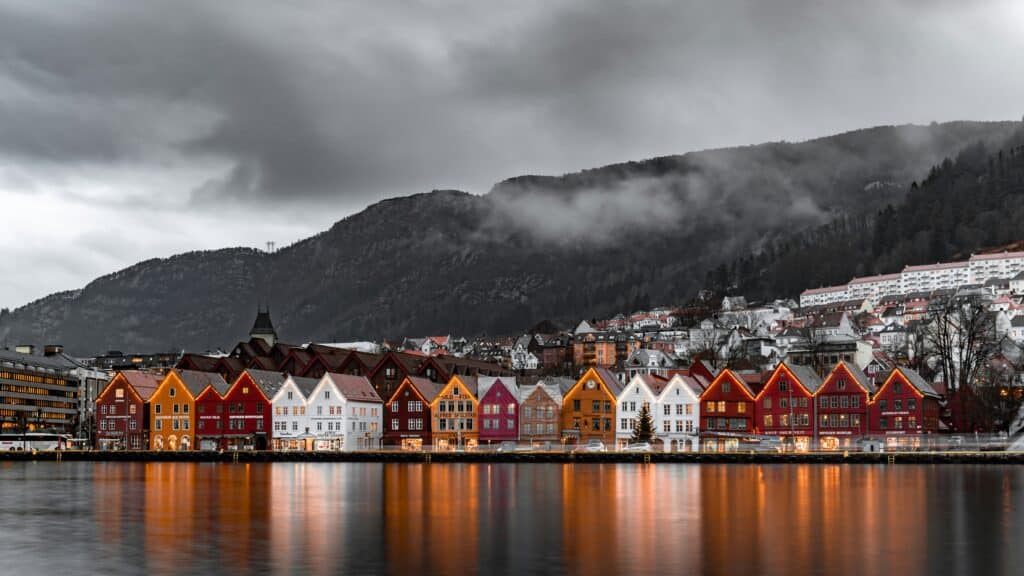Barcelona is a city that blends stunning architecture, rich history, and a vibrant Mediterranean atm...
Travel Guides
Norway, with its stunning fjords, vibrant cities, and the mesmerizing Northern Lights, offers unique experiences throughout the year - that is why close to 11.5 million people visit Norway each year. But the question that presents itself is when is the best time to go to Norway? Explore our comprehensive guide to learn when is […]



Norway, with its stunning fjords, vibrant cities, and the mesmerizing Northern Lights, offers unique experiences throughout the year - that is why close to 11.5 million people visit Norway each year. But the question that presents itself is when is the best time to go to Norway?
Explore our comprehensive guide to learn when is the best weather to visit this country, what are the cheapest months, how to pack, and some notable Norway eSIM providers.
Norway's diverse climate and geography mean that each season offers distinct attractions.
Ultimately, the best time to visit will depend on your preferred weather and activities. Here’s a breakdown of what to expect in Norway depending on the season:
The average temperature ranges from -6°C in inland areas to 0°C along the coast. This is the prime time for winter sports enthusiasts. Northern regions, especially around Tromsø, offer excellent opportunities for Northern Lights viewing. Ski resorts are in full swing, and activities like dog sledding and snowshoeing are popular.
The average temperature ranges from around 1°C in March, rising to 10°C by May. As snow melts, waterfalls are at their most powerful, making it a great time for fjord cruises. Early hiking trails open up, and the blooming flora adds vibrant colors to the landscapes.
The average temperature typically ranges between 12°C and 18°C, with southern regions occasionally experiencing warmer days. The extended daylight hours due to the Midnight Sun allow for prolonged outdoor activities. Popular pursuits include hiking iconic trails like Preikestolen, cycling through scenic routes, attending music and cultural festivals, and exploring coastal towns.
Decrease from around 7°C in September to 2°C by November. The autumnal colors make it a picturesque time for photography and nature walks. It's also the season for foraging, with various cultural events taking place, and it's a quieter time to visit popular tourist spots.
| Season | Months | Temperature (°F) [°C] | Activities |
| Winter | December–February | 21 to 32 (-6 to 0) | Northern Lights viewing, skiing, dog sledding, snowshoeing |
| Spring | March–May | 34 to 50 (1 to 10) | Fjord cruises, waterfall sightseeing, early hiking |
| Summer | June–August | 54 to 64 (12 to 18) | Midnight Sun experiences, hiking, cycling, festivals, exploring coastal towns |
| Autumn | September–November | 45 to 35 (7 to 2) | Autumn foliage viewing, mushroom and berry foraging, cultural events |
Norway boasts a vibrant calendar of events and festivals throughout the year, offering visitors a rich cultural experience.
Here's an overview of some notable annual events:
| Month | Event Name | Description |
| January | Tromsø International Film Festival | Showcases a diverse selection of films from around the world. |
| February | Sami National Day | Celebrated on February 6th, honoring the indigenous Sami people with cultural events and festivities. |
| March | Oslo International Church Music Festival | Features performances of sacred music in various churches across Oslo. |
| April | Easter Celebrations | Widely celebrated with various cultural and religious events throughout Norway. |
| May | Constitution Day (17th May) | A national holiday commemorating the signing of the Norwegian Constitution in 1814, marked by parades and festivities. |
| June | Norwegian Wood Rock Festival | An annual rock music festival held in Oslo, attracting international artists and large audiences. |
| July | Midnight Sun Marathon | Held in Tromsø, this marathon allows participants to run under the midnight sun. |
| August | Oslo Jazz Festival | A six-day jazz festival featuring performances by international and local artists. |
| Oslo Chamber Music Festival | An annual event where world-class chamber musicians perform in various venues around Oslo. | |
| December | Nobel Peace Prize Ceremony | Held annually in Oslo, this prestigious event honors individuals and organizations for their contributions to peace. |
Traveling during the shoulder seasons of spring (March–May) and autumn (September–November) can offer more affordable rates on accommodations and flights. These periods see fewer tourists, allowing for a more intimate experience of Norway's attractions.
Typically, you can expect to pay the following prices, depending on where and when you are in Norway:
Average Meal:
Average Drink:
Average Stay at a Budget Hotel:
Luxurious Price of a Hotel:
Attractions:
Car Rental:
The ideal duration for a trip to Norway largely depends on your interests and the experiences you wish to have.
Here's a breakdown to help you plan:
Ultimately, the length of your stay should align with your interests, whether they're urban experiences, natural wonders, or cultural immersion.
Packing the right way ensures you don’t walk with wet feet or face the cold in a light jacket. Depending on your planned activities, it is essential that you pack accordingly.
Here are some things to consider:
Clothing:
Other Essentials:
As a U.S. citizen, you can travel to Norway for tourism or business without a visa for stays of up to 90 days within a 180-day period, under the Schengen Agreement. Ensure you have the following:
Norway boasts excellent internet infrastructure, ensuring travelers can stay connected.
Some of the options that you can consider are:
When traveling to Norway, staying connected is essential for navigation, communication, and sharing your experiences.
eSIMs offer a convenient and flexible alternative to traditional SIM cards, allowing you to access mobile data without the need to swap physical cards.
Here are some notable eSIM providers for Norway:
Saily provides eSIM solutions for international travelers, offering coverage in over 150 countries, including Norway. Their plans are designed to offer flexibility and convenience, ensuring users remain connected during their travels.
Pros:
Cons:
Airalo is a prominent eSIM provider offering a variety of data plans for travelers. Their Norway-specific eSIMs provide reliable connectivity, allowing users to manage their plans through an intuitive mobile app.
Pros:
Cons:
Holafly specializes in providing eSIMs with unlimited data options for travelers. Their Norway eSIM ensures users can enjoy seamless internet access without worrying about data caps.
Pros:
Cons:
Explore the pricing of some of the top eSIM providers for Norway:
| Provider | Plan | Duration | Price |
| Saily | 1GB | 7 Days | $3.99 |
| Airalo | 1GB | 7 Days | $4.50 |
| Holafly | Unlimited | 7 Days | $29.90 |
The ideal time to visit Norway depends on your interests. For pleasant weather and extended daylight, consider the summer months of June to August. If you prefer fewer crowds and vibrant autumn colors, September and October are excellent choices. For winter activities and the Northern Lights, December to February are ideal.
Traveling during the shoulder seasons—May, early June, late August, and September—can offer more affordable rates on accommodations and flights. These periods see fewer tourists, allowing for a more intimate experience of Norway's attractions.
The prime time to witness the Northern Lights in Norway is from late September to late March, with peak visibility during the darkest months of December to February. Northern regions, especially around Tromsø, offer excellent opportunities for Northern Lights viewing.
Norway is known for its high cost of living, which extends to travel expenses. However, by planning ahead and traveling during the shoulder seasons, you can find more affordable accommodations and flights. Additionally, many of Norway's natural attractions are free to access, allowing for budget-friendly experiences.
A regular coffee or tea costs around $3 – $4 (30 – 40 NOK), while a cappuccino or latte is about $5 – $7 (50 – 70 NOK).

